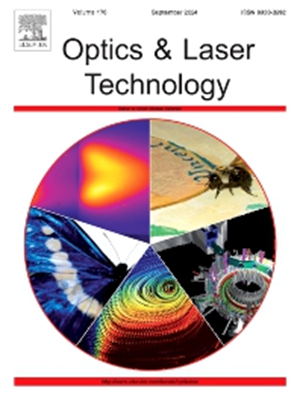3 kW narrow-linewidth linearly polarized fiber laser with high-purity single-mode output and high PER enabled by suppressing mode and polarization coupling
IF 4.6
2区 物理与天体物理
Q1 OPTICS
引用次数: 0
Abstract
Laser beam combining techniques, such as coherent and spectral beam combination, are effective strategies for the further power scaling of fiber lasers. In practical applications, beam quality and polarization extinction ratio (PER) of the narrow-linewidth fiber laser sources can significantly affect the performance of the combining system, including the combining efficiency, beam quality, and thermal regulation. In this paper, a narrow-linewidth linearly polarized fiber laser with high-purity single-mode output and high PER is demonstrated. A theoretical model for the optimization of our amplifier is firstly constructed, considering mode coupling and thermal-induced polarization coupling. Expression of the birefringence employed here is the recently corrected stress-induced birefringence. With this model, we optimize the numerical aperture, bending radius and coiling configurations of gain fiber for suppressing mode coupling and polarization coupling. In experiment, we achieve a 3.116 kW linearly polarized narrow-linewidth fiber laser with the beam quality of Mx2 = 1.09/My2 = 1.06 and a PER of 22.1 dB at maximum power. The thresholds for transverse mode instability, stimulated Brillouin scattering, and self-pulsing are not reached. This work provides an effective design method for high-performance narrow-linewidth linearly polarized fiber lasers. To the best of our knowledge, our results represent the highest level of both beam quality and PER achieved for narrow-linewidth linearly polarized fiber lasers at this power level.
求助全文
约1分钟内获得全文
求助全文
来源期刊
CiteScore
8.50
自引率
10.00%
发文量
1060
审稿时长
3.4 months
期刊介绍:
Optics & Laser Technology aims to provide a vehicle for the publication of a broad range of high quality research and review papers in those fields of scientific and engineering research appertaining to the development and application of the technology of optics and lasers. Papers describing original work in these areas are submitted to rigorous refereeing prior to acceptance for publication.
The scope of Optics & Laser Technology encompasses, but is not restricted to, the following areas:
•development in all types of lasers
•developments in optoelectronic devices and photonics
•developments in new photonics and optical concepts
•developments in conventional optics, optical instruments and components
•techniques of optical metrology, including interferometry and optical fibre sensors
•LIDAR and other non-contact optical measurement techniques, including optical methods in heat and fluid flow
•applications of lasers to materials processing, optical NDT display (including holography) and optical communication
•research and development in the field of laser safety including studies of hazards resulting from the applications of lasers (laser safety, hazards of laser fume)
•developments in optical computing and optical information processing
•developments in new optical materials
•developments in new optical characterization methods and techniques
•developments in quantum optics
•developments in light assisted micro and nanofabrication methods and techniques
•developments in nanophotonics and biophotonics
•developments in imaging processing and systems

 求助内容:
求助内容: 应助结果提醒方式:
应助结果提醒方式:


